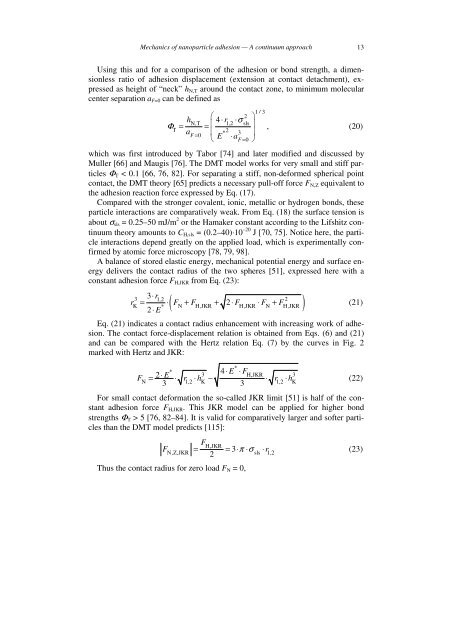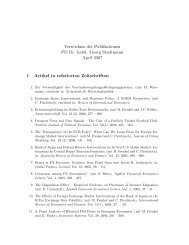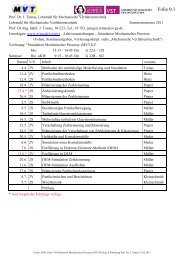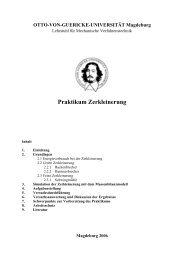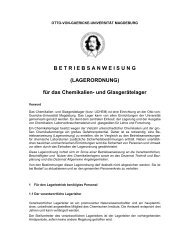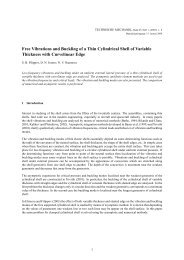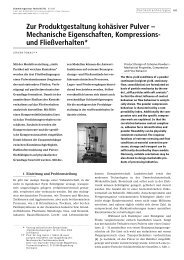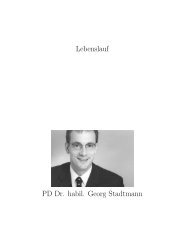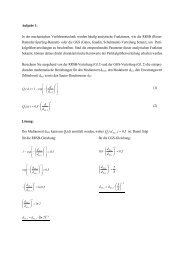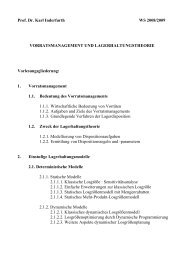Mechanics of nanoparticle adhesion â A continuum approach
Mechanics of nanoparticle adhesion â A continuum approach
Mechanics of nanoparticle adhesion â A continuum approach
You also want an ePaper? Increase the reach of your titles
YUMPU automatically turns print PDFs into web optimized ePapers that Google loves.
<strong>Mechanics</strong> <strong>of</strong> <strong>nanoparticle</strong> <strong>adhesion</strong> — A <strong>continuum</strong> <strong>approach</strong> 13Using this and for a comparison <strong>of</strong> the <strong>adhesion</strong> or bond strength, a dimensionlessratio <strong>of</strong> <strong>adhesion</strong> displacement (extension at contact detachment), expressedas height <strong>of</strong> “neck” h N,T around the contact zone, to minimum molecularcenter separation a F=0 can be defined as2h NT ,4⋅r12 ,⋅σslsΦT = = a2F = 0 * 3E a ⋅F = 0 1/3, (20)which was first introduced by Tabor [74] and later modified and discussed byMuller [66] and Maugis [76]. The DMT model works for very small and stiff particlesΦ T < 0.1 [66, 76, 82]. For separating a stiff, non-deformed spherical pointcontact, the DMT theory [65] predicts a necessary pull-<strong>of</strong>f force F N,Z equivalent tothe <strong>adhesion</strong> reaction force expressed by Eq. (17).Compared with the stronger covalent, ionic, metallic or hydrogen bonds, theseparticle interactions are comparatively weak. From Eq. (18) the surface tension isabout σ sls = 0.25–50 mJ/m 2 or the Hamaker constant according to the Lifshitz <strong>continuum</strong>theory amounts to C H,sls = (0.2–40)⋅10 –20 J [70, 75]. Notice here, the particleinteractions depend greatly on the applied load, which is experimentally confirmedby atomic force microscopy [78, 79, 98].A balance <strong>of</strong> stored elastic energy, mechanical potential energy and surface energydelivers the contact radius <strong>of</strong> the two spheres [51], expressed here with aconstant <strong>adhesion</strong> force F H,JKR from Eq. (23):( 2, , , )3⋅rr F F F F F2⋅E3 12 ,2= ⋅ + + ⋅ ⋅ +K * N HJKR HJKR N HJKR(21)Eq. (21) indicates a contact radius enhancement with increasing work <strong>of</strong> <strong>adhesion</strong>.The contact force-displacement relation is obtained from Eqs. (6) and (21)and can be compared with the Hertz relation Eq. (7) by the curves in Fig. 2marked with Hertz and JKR:**⋅ E34⋅E⋅FH,JKR3N 12 , K 12 , KF = 2 ⋅ r ⋅h − ⋅ r ⋅ h(22)3 3For small contact deformation the so-called JKR limit [51] is half <strong>of</strong> the constant<strong>adhesion</strong> force F H,JKR . This JKR model can be applied for higher bondstrengths Φ T > 5 [76, 82–84]. It is valid for comparatively larger and s<strong>of</strong>ter particlesthan the DMT model predicts [115]:FHJKR,FNZJKR , ,= = 3⋅π ⋅σ2sls⋅ r12,(23)Thus the contact radius for zero load F N = 0,


